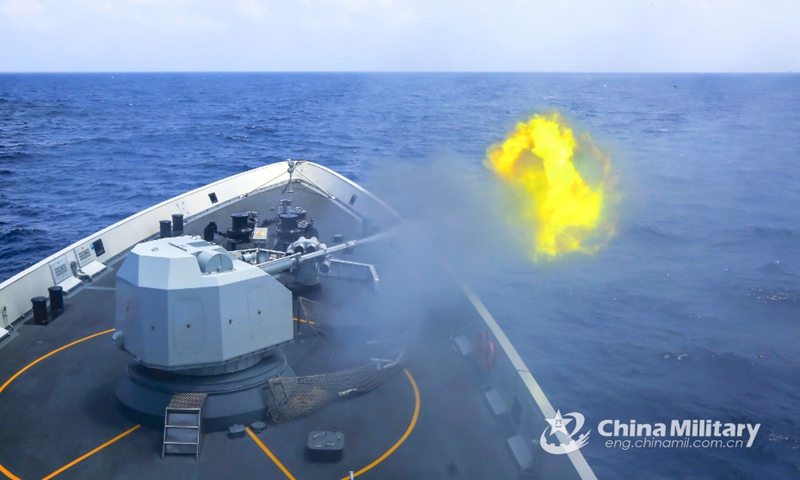Will South China Sea become China-US ‘tipping point?’
By Chen Xiangmiao Source: Global Times Published: 2020/7/12 20:58:40

The guided-missile frigate Yulin (Hull 569) attached to a destroyer flotilla with the navy under the PLA Southern Theater Command fires its main-gun against mock ashore targets during a maritime training exercise in waters of the South China Sea in late March, 2020. The guided-missile frigates Xuchang (536) and Yulin (Hull 569) jointly execute maritime tasks on subjects including formation maneuver, live-fire operation, anti-submarine warfare (ASW) operation, joint salvage, etc. (eng.chinamil.com.cn/Photo by Li Hongming and Li Wei)
Since the beginning of last month, the US has again increased tensions in the South China Sea. In June, US aircraft carrier strike groups were deployed again after rest and reorganization due to the impact of the COVID-19 epidemic. The US and Japan conducted joint military drills in the South China Sea in late June. Since July 4, the US military has deployed the USS Nimitz and USS Ronald Reagan Carrier Strike Groups to conduct dual carrier operation amid China's drills around the Xisha Islands. Indeed, that China and the US seem to have been at loggerheads in the South China Sea arouses concerns about whether a naval clash between the two might break out. It begs the question: Will the South China Sea become a "tipping point" for China-US confrontation?The China-US competition in the South China Sea is worrying. The strategic competition between the two countries is at its worst since the Cold War - in fact some call this a "new Cold War." After the epidemic broke out in America, the US military has increased operations in the South China Sea, pushing China-US naval competition to new levels.
The US is escalating its military deterrence against China. Since the beginning of this year, it has stepped up its so-called freedom of navigation operations in the South China Sea. Recently, for several consecutive days five US military reconnaissance aircraft have flown close to South China's Guangdong Province. The US has deployed three US nuclear-powered aircraft carriers around the South China Sea in June. The existing crisis management mechanisms are becoming strained because of the higher frequency of unpleasant encounters.
Given the status quo, there are at least two possible scenarios where the two sides might clash.
First, under constant provocations and threats from the US, China will have no choice but to upgrade its countermeasures, which could cause Washington to resort to more dangerous military tactics.
Second, if a conflict happens between China and US allies (like Vietnam, the Philippines and Malaysia) over their control and resource development in disputed waters, Washington will provide them support; either because of bilateral agreements or out of its own motivations. Either way, this could trigger direct military conflicts between China and US.
Compared to previous tensions over the last decade, unpredictable unilateralism and adventurism of the Trump administration have accelerated contradictions between China and the US in the South China Sea. Furthermore, the US seeks to divert public opinion away from its failures with COVID-19 by hyping so-called China threats in the South China Sea. The US also intends to demonstrate its abilities and intent to offer protection to its allies and security partners by flexing military muscle in the South China Sea.
Once military clashes really break out between China and the US, Tokyo and Canberra, as two major US allies, will offer support for Washington with supportive military actions. Furthermore, Vietnam - for now the most significant partner of the US in Southeast Asia - will also stand with the US to maximize its benefits in the South China Sea. The difference is that Vietnam may take into consideration the importance of Sino-Vietnamese relations and avoid participating in military operations. But Hanoi will very likely provide the Cam Ranh Bay to the US military.
However, no country will have an absolute win over the sea. Strategically, the US has the upper hand of having more military allies and security partners than China does. But these US allies and partners have concerns with the deteriorating regional security environment and the potential losses that might incur with a China-US clash in the South China Sea.
In the future, China shouldn't be led by the nose by the US. It should take actions to gain advantages. In face of provocations and pressure brought by the US military, China could strengthen capabilities for battlefields, enhance equipment for deployment, and further demonstrate its military power. This will be necessary to safeguard its national security and also restore balance in the Asia-Pacific region.
The author is an assistant research fellow, National Institute for South China Sea Studies. opinion@globaltimes.com.cn
Posted in: VIEWPOINT